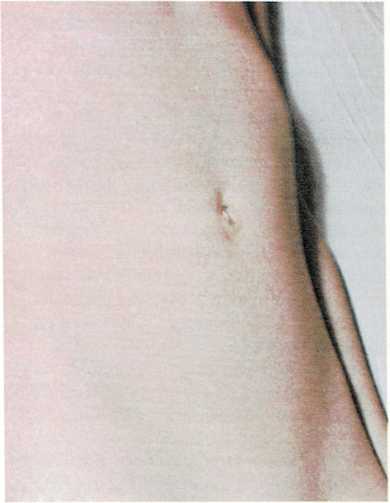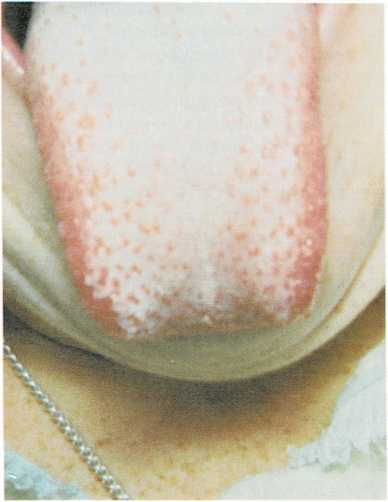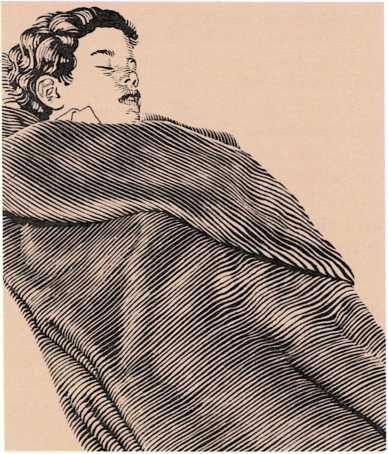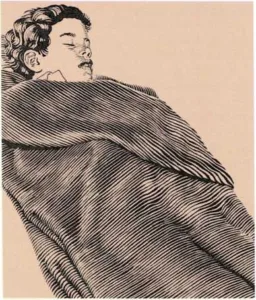Scald – Shock
Saint Vitus’s dance. See Chorea; Rheumatic fever
Scald. See Burns

The deep red rash that a child develops with a case of scarlet fever
looks like a sunburn with goose pimples.
Scarlet fever is a contagious disease that is caused by the same
streptococcus bacteria that produces sore throats, swollen glands,
tonsillitis, ear abscesses, and other infections. A person with a
streptococcal infection can spread scarlet fever even though the person
does not have scarlet fever. For example, a child may develop scarlet
fever after picking up the bacteria from someone in whom the
streptococcus produced only a sore throat.
First symptoms of the disease come on suddenly—high fever, sore
throat, chills, vomiting, and headache. Early treatment prevents
spreading the disease to others, so call your doctor whenever your child
has a sore throat and a fever.
Two to three days after the first symptoms appear, the child breaks out
in a deep red rash. The rash resembles a sunburn with goose pimples and
may feel like sandpaper. It consists of pinhead-sized, raised spots that
are close together. The rash begins on the child’s neck and in the groin
and armpits. Then it gradually spreads over the rest of the body and the
sides of the face. The area around the mouth is pale. The throat is
inflamed, and the tongue becomes red and pitted looking. After the rash
fades,

In the early stages of scarlet fever, the tongue is coated. Then it
becomes red and pitted looking (strawberry tongue).
the child’s skin usually peels or flakes off for three to eight weeks.
If the rash is widespread, peeling will be extensive. Scarlet fever
usually affects children between 3 and 12 years old.
Doctors usually prescribe penicillin or other antibiotics to treat
scarlet fever. Isolate the child for about seven days—or longer if the
doctor so advises. Remind the child to cover the mouth and nose when
sneezing or coughing. Provide tissues for this and burn the used tissues
in a safe place. Scarlet fever is contagious for two to five days before
symptoms appear and for about 24 to 48 hours after treatment with
antibiotics starts.
Scarlet fever was once considered a very serious disease. Prompt use of
antibiotics in treating streptococcal throat infections has currently
reduced its threat and incidence. The virulence or strength of the
bacteria can, however, change over the course of time. H.D.R.. Jr.
See also Sore throat; Strep throat
Scoliosis (curvature of the spine) is a condition in which the spine
curves from one side to the other. Scoliosis occurs in about 3 per cent
of the young population. It is more common in girls than in boys, and
causes the child to appear to stand with a crooked posture. School
screening programs for early detection of scoliosis are now common and
very effective. Consult your doctor if you suspect your child has
scoliosis. Your doctor may suggest that you take the child to an
orthopedist (physician specializing in deformities and diseases of bones
and joints).
There are two types of scoliosis—functional and structural. Functional
scoliosis may be caused by poor posture, a short leg, or muscle spasms
around the hip or back. It is not considered serious and does not result
in any bone changes. Functional spinal curves are flexible and disappear
when the child lies down. Functional scoliosis can be treated by
correcting poor posture with exercises, fitting the child with special
correction devices such as a built-up shoe, or prescribing drugs to
relax muscle spasms.
Structural scoliosis is a spinal deformity that begins in childhood and
usually results
in permanent bone changes. In some children scoliosis may be caused by a
spinal deformity that was present at birth. In others, it may be caused
by a disease that deforms the bones of the spine during growth. Doctors
do not know what causes scoliosis in about 80 per cent of the affected
children.
Although structural scoliosis is rarely painful, it causes deformity
because compensatory curves develop above and below the affected portion
of the spine. Unlike a functional curve, a structural curve does not
disappear when the child lies down. Frequently, one hip and the opposite
shoulder appear higher than on the opposite side. The chest appears
off-center in relation to the pelvis. The backs of the ribs bend out,
pushing out the shoulder blade. When the child bends forward, a hump
appears on one side of the upper back. Although the deformity caused by
structural scoliosis frequently worsens as the child grows, this is not
always the case. Early diagnosis, advice, and treatment are important.
Treatment of structural scoliosis depends on the severity of the curve.
Mild curves are simply followed and watched by the doctor. A child with
a moderate curve is usually fitted with a Milwaukee brace, a
straightening device that may have to be worn for several years. Severe
curves, or curves that progressively worsen, should be corrected
surgically. Structural scoliosis can rarely be completely cured, but
early treatment can lessen its deforming effects, [j j.g.]
Shock is one of the body’s reactions to physical or infectious
stress. The normal flow of blood is upset and normal functions of the
body are weakened. A child suffering from shock may be weak or faint;
may become pale; may have cold, clammy skin; and may have a weak,
irregular, or “fluttering” pulse. Nausea and vomiting are also common in
shock.
Bleeding, major burns, severe pain, infection, and severe injury such as
a broken bone may cause shock. Fear or other strong emotions may cause a
different kind of shock.
A child in shock should be placed on a flat surface. If blood has been
lost, legs should
First aid for shock

A child in shock should be placed on a flat surface. Wrap the child
in a blanket. This will help keep the body temperature normal.
vent serious complications from a disease. Although curative drugs may
be given orally, doctors may decide to give them by injection for
several reasons. The drug more quickly enters the blood stream to fight
the disease; the drug is not tasted (regardless of how well the taste of
oral drugs is disguised, some children refuse to take a second dose, or
they vomit it); and the doctor is certain that the drug has been taken.
Doctors give desensitizing shots to many children who are allergic to
substances from which they cannot constantly be protected. These shots
are injected into the child in small, but increasing, doses. As a result
of the repeated shots, the child’s body manufactures antibodies and
effects cellular changes that lessen the allergic reaction.
If your child is allergic, or has had a previous reaction to a drug, and
your doctor does not already know about the condition, be sure to tell
the doctor. Penicillin and other drugs may cause undesirable reactions.
Your attitude and that of the doctor and nurse can influence the child
who is fearful of getting shots. Be truthful when a child
be elevated. To prevent loss of normal body heat, the child should be
wrapped in a blanket. A hot-water bottle or other artificial heat should
not be used, since too much heat draws blood to the skin and away from
more vital organs where it is needed.
If your child is in shock, call the doctor promptly or take the child to
a hospital. Most forms of shock need immediate, specific treatment,
[m.g.]

